Rubber Testing Equipment
Standards






The UV discoloration meter is a machine is used to simulate an environment of sunlight radiation on a specimen to identify the resistance of fabric to discoloration. NextGen offers two primary models based on size and temperature regulations to help meet your ASTM standards.
Specifications
| Model # | NG-DISCO-A | NG-DISCO-B |
|---|---|---|
| Light Source | 2pcs Germicidal UV Lamps | 2pcs Germicidal UV Lamps |
| Control Display: | LED, 0-999999 | LED, 0-999999 |
| Inner Dimensions: | 19.7x11.8x13.75" (50x30x35cm) |
21.65x23.62x21.65" (500x600x500mm) (150L) |
| Outer Dimensions: | 21.65x14.15x22.45" (55x36x57cm) |
26.4x29x57" (670x740x1450mm) |
| Temperature | RT-200℃ | RT-200℃ |
| Weight | 40lbs (18kg) | 80lbs (36kg) |
| Power | 220V/50HZ | 220V/50HZ |
| Standard Accessories | Main Unit Sample Rack (1 set) Lamps (2 pcs) |
Main Unit Sample Rack (1 set) Lamps (2 pcs) |
FAQs
The Discoloration Meter is designed to measure the resistance of materials, especially fabrics, to discoloration when exposed to simulated sunlight radiation. This process helps evaluate how materials will maintain their original color over time under sunlight exposure, which is particularly significant for industries such as textiles, clothing, and upholstery.
This equipment allows manufacturers and quality control teams can accurately predict how a fabric or material will age, improving product quality and durability. By simulating long-term exposure in a controlled environment, the machine provides valuable data for colorfastness, helping to meet industry standards.
Click here to learn more about the product or here to receive a personalized quote.
Yes, the Discoloration Meter is designed to comply with ASTM D1148-95 standards, which specifically address the discoloration of rubber, plastics, and similar materials when exposed to ultraviolet light or other radiant energy sources. This standard outlines the procedures for testing and evaluating UV light effects on the material's color stability.
The Discoloration Meter replicates these conditions in a controlled testing environment. It assesses how materials react to sunlight or UV radiation over time. This compliance means that manufacturers can meet industry standards by using this meter to perform consistent and reliable testing of materials prone to fading or discoloration. Compliance with ASTM D1148-95 is particularly important for ensuring the longevity and visual quality of products used in outdoor or UV-exposed applications, such as automotive parts, textiles, and rubber materials.
Click here to learn more about the product or here to receive a personalized quote.
NextGen Material Testing, Inc. offers two types of Discoloration Meters to suit your testing needs: NG-DISCO-A and NG-DISCO-B. The main differences between these two models are the size and the way in which the temperature is regulated. The NG-DISCO-A is designed for standard applications, suitable for smaller materials or environments that do not require strict temperature control.
NG-DISCO-B, on the other hand, offers advanced temperature regulation, which makes it ideal for testing larger samples or materials that are exposed to extreme environments. For example, industries needing to test outdoor materials or automotive parts would benefit from the NG-DISCO-B, as it simulates more rigorous environmental conditions. Both models are ASTM D1148-95 compliant, allowing for precise and reliable discoloration resistance testing.
Click here to learn more about the product or here to receive a personalized quote.
Our Discoloration Meter models use two germicidal UV lamps as the primary light source. These lamps are specifically designed to emit ultraviolet (UV) light, which is crucial for simulating sunlight exposure during discoloration testing. UV light helps replicate the environmental conditions that materials, such as textiles, rubber, and plastics, are exposed to over time, allowing for an accurate assessment of their colorfastness and resistance to fading or discoloration.
The use of germicidal UV lamps ensures precise, consistent testing, making it an ideal choice for industries that require compliance with standards like ASTM D1148-95. These lamps contribute to the machine's ability to provide reliable and repeatable results for quality control and material durability analysis.
Click here to learn more about the product or here to receive a personalized quote.
The Discoloration Meter is equipped with an LED control display that shows values from 0 to 999999. This type of display offers a clear and precise interface for users to monitor and control the testing process. It allows for easy tracking of time, test duration, and operational settings, which are critical for providing accurate and consistent results during discoloration testing.
The LED display is user-friendly and provides real-time data, making adjustments quick and efficient. Whether performing routine quality control or testing materials for compliance with requirements, the clear visibility of this display makes it easier to manage the entire process. Its expansive array of displayed values also offers a variety of test parameters.
Click here to learn more about the product or here to receive a personalized quote.
The Discoloration Meter is available in two models with different inner dimensions to accommodate various testing needs. The NG-DISCO-A model features inner dimensions of 19.7 x 11.8 x 13.75 inches (50 x 30 x 35 cm), making it ideal for smaller samples or more compact testing requirements. On the other hand, the NG-DISCO-B model is larger, with inner dimensions of 21.65 x 23.62 x 21.65 inches (500 x 600 x 500 mm) and a capacity of 150 liters. This larger model is suitable for testing bulkier materials or when greater testing volume is needed.
Regardless of the size of the test process, both models provide users with the ability to choose the model that best fits their material size and testing conditions, depending on which model they choose.
Click here to learn more about the product or here to receive a personalized quote.
The Discoloration Meter models vary in outer dimensions, accommodating different testing environments and space requirements. The NG-DISCO-A model has outer dimensions of 21.65 x 14.15 x 22.45 inches (55 x 36 x 57 cm), making it compact and suitable for smaller laboratory spaces or testing setups. In contrast, the NG-DISCO-B model has larger outer dimensions of 26.4 x 29 x 57 inches (670 x 740 x 1450 mm), which makes it ideal for more spacious environments and for users handling larger testing volumes.
Due to these differences, users have the opportunity to choose the correct model for their workspace and testing needs, offering flexibility both in terms of capacity and installation space.
Click here to learn more about the product or here to receive a personalized quote.
Both the NG-DISCO-A and NG-DISCO-B models of the Discoloration Meter have a temperature range of room temperature (RT) to 200°C. It is possible to simulate a variety of environmental conditions with this wide temperature range, making it possible to test rubber, plastics, and textile discoloration resistance to a variety of different environmental conditions. Consistent temperature control across both models allows for reliable and repeatable test results, regardless of the material being tested or the specific application requirements.
Because of their temperature versatility, both models are ideal for industries requiring compliance with standards such as ASTM D1148-95, where controlled heat exposure is crucial for allowing an accurate test of colorfastness.
Click here to learn more about the product or here to receive a personalized quote.
The Discoloration Meter is offered in two models with different weights to suit various testing needs. The NG-DISCO-A model weighs 40 lbs (18 kg), making it lighter and portable. This model is ideal for smaller testing environments or laboratories where space is limited, and frequent equipment movement may be necessary.
In contrast, the NG-DISCO-B model weighs 80 lbs (36 kg), reflecting its larger size and higher testing capacity. The increased weight makes this model more suitable for heavy-duty testing or for laboratories that require a more robust setup for handling larger samples. The weight difference between the two models provides flexibility, allowing users to select the option that best fits their workspace and material testing requirements. This guarantees that each model can meet different operational needs, whether for small-scale or larger, more intensive testing environments.
Click here to learn more about the product or here to receive a personalized quote.
The Discoloration Meter operates on a standard power supply of 220V at 50Hz. This power specification guarantees that the machine has the necessary energy to operate efficiently in various testing environments. Both the NG-DISCO-A and NG-DISCO-B models are equipped to function with this power setup, making them compatible with industrial and laboratory facilities that use this voltage standard.
A consistent power supply is crucial for maintaining accurate operation of the UV lamps and temperature controls, which are essential for conducting precise discoloration and UV resistance testing. Having a stable 220V/50Hz power configuration means that the equipment can deliver reliable results, without performance fluctuations, regardless of the model or testing application. This helps industries maintain high testing standards and produce consistent results for materials that withstand UV exposure and discoloration over time.
Click here to learn more about the product or here to receive a personalized quote.
The Discoloration Meter includes several standard accessories to allow for immediate use. These accessories include the main unit, which houses all the necessary components for testing, and a sample rack set, which securely holds the materials being tested for discoloration. Additionally, the meter comes equipped with two UV lamps, which are crucial for simulating sunlight and performing accurate discoloration testing.
These standard accessories provide users with everything they need to test materials effectively. The sample rack allows for secure placement of test materials, while the UV lamps provide consistent light exposure for reliable test results. This complete setup assures that the Discoloration Meter is ready for various industrial and laboratory applications, providing compliance with testing standards such as ASTM D1148-95.
Click here to learn more about the product or here to receive a personalized quote.
Related Products

NG-EML Series A – Single Column Bench Top Universal Testing Machine (50 N – 5 kN)
The NG-EML Series A – Single Column Bench Top UTM (50 N–5 kN) is a precision electromechanical system designed for tension, compression, and flexural testing of low-force specimens. Featuring GenTest™ software, a high-speed servo drive, Class 0.5 accuracy, and USB/Ethernet control, this compact tabletop unit supports ASTM, ISO, and EN standards. Ideal for testing plastics, rubber, foams, films, composites, and thin metals.
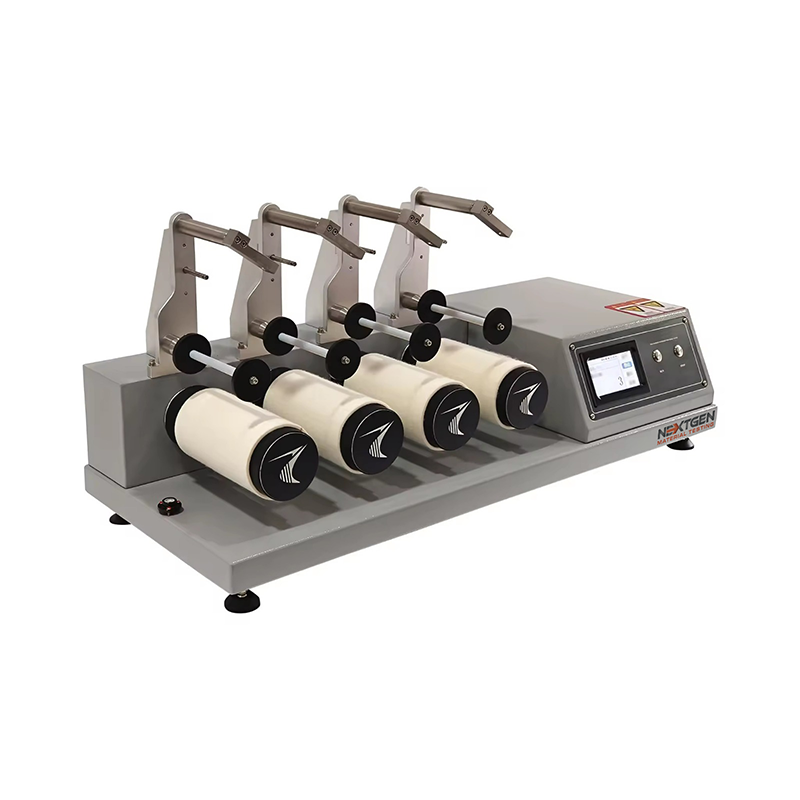
ICI / Mace Snag Tester
Discover the Fabric Textile ICI / Mace Snag Tester, a reliable tool for assessing fabric snagging under normal wear conditions.
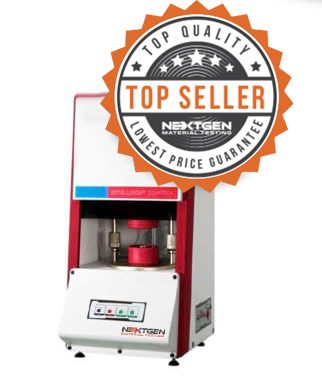
Moving Die Rheometer (MDR)
Introducing the NG-MDR Moving Die Rheometer, your solution for accurately assessing the curing and processing characteristics of vulcanized rubber compounds. Designed for precision, this state-of-the-art rheometer captures the characteristic curve and parameters of rubber vulcanization by measuring the torque applied to the oscillating die.

Aging Oven – High-Temperature Chamber – NG-AGOV-ADV
The NG-AGOV-ADV Aging Oven is designed for high-temperature testing of rubber, plastics, and insulating materials. It features programmable PID control, uniform airflow, and forced convection for stable and repeatable aging cycles. This system supports global testing standards including ISO 188, ASTM D573, and IEC 60216-4-1. With its durable stainless-steel chamber and user-friendly interface, it’s ideal for R&D, quality control, and certification labs.

NG-T-Press M Series - Manual Cutting Press System for Rubber Tensile Specimens
Our newest manual cutting press system is suitable for laboratories to create specimens from rubber, tape, and special materials.

Rotary Abrasion Tester Single & Dual Wheel
GenRotary used evaluate abrasion resistance. It can conduct tests on a wide range of materials such as: cloth, paper, paint, plywood, leather, tile, glass, rubber etc. It tests the specimen by rotating it while in contact with the grinding wheel and applying the required pressure. The Joss of weight reflects on the change in weight of the specimen. The unit also has an intelligent power failure recovery function.

9-Station Martindale Abrasion Tester
The GenDale - Martindale Abrasion Tester is mainly used to test shoe fabric, shoe lining, and many other types of shoe related materials.
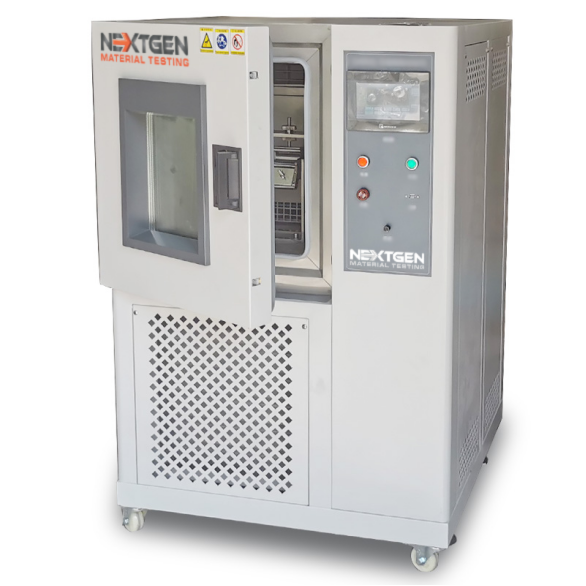
GenRoss-CH - Ross Flex Tester with Low Temperature Chamber
GenRoss-CH is an advanced Ross Flex Tester designed for assessing the cold resistance of materials in low temperature environments.

Linear Abrasion Tester
NextGen's linear abrasion meters evaluate the abrasion and scratch resistance of products, along with color transmission.

NextGen Environmental Chambers NG-EC 100,150,225,408,1000
The temperature and humidity NextGen Environmental Chambers features a sturdy cabinet made of cold-rolled steel and stainless steel.

digiChamber - Temperature Controlled Hardness Testing
Discover digiChamber from NextGen Material Testing, the advanced temperature-controlled hardness tester developed by Bareiss.

HDA 120 - Hardness and Density Automation Test System
The HDA 120 test system is a versatile solution for semi-automatic detection of sample hardness and density.

RPA Ultra - Advanced Rubber Process Analyzer Rheometer
RPA Ultra is an advanced rubber process analyzer rheometer that measures the dynamic and static characteristics of raw rubber compounds

NG-EML Series B – Dual Column Bench Top Universal Testing Machine (100 N – 10 kN)
The NG-EML Series B is a high-precision dual-column benchtop universal testing machine engineered for tensile, compression, and flexural testing in the 0.1 kN to 10 kN range. It features Class 0.5 accuracy, a rigid FEM-optimized frame, and a direct-drive servo system with advanced closed-loop control, making it ideal for testing rubber, plastics, metals, composites, and high-performance polymers in both R&D and quality assurance settings.
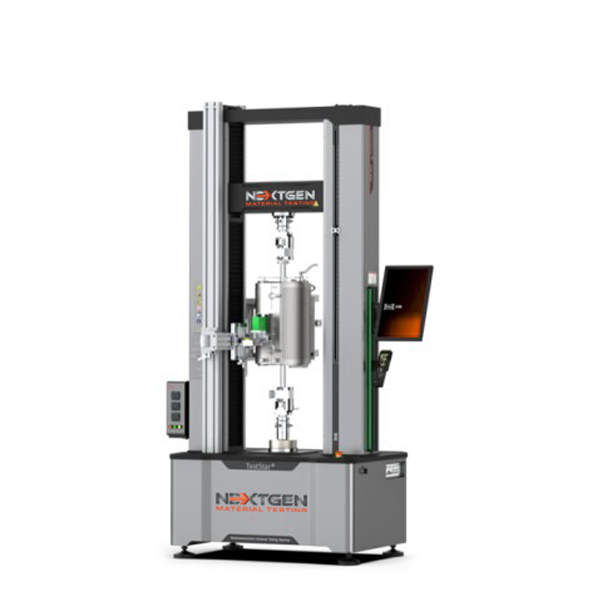
NG-EML Series C – Dual Column Bench Top and Floor Standing Universal Testing Machine (5 kN – 50 kN)
The NG-EML Series C is a precision-engineered dual-column universal testing machine for tension, compression, and flexural testing of metals, composites, rubbers, and polymers. Available in both bench-top and floor-standing formats, with force capacities from 5 kN to 50 kN and Class 0.5 accuracy.

NG-EML Series D – Floor Standing Universal Testing Machine (50 kN – 1000 kN)
The NG-EML Series D – Floor Standing Universal Testing Machine (50 kN–1000 kN) is a dual-column system for tensile, compression, flexural, shear, and cyclic testing of high-strength metals, composites, polymers, and advanced materials. Available in single-space and dual-space configurations, it meets ASTM E8, ISO 6892-1, ISO 527, and GB/T 228 standards. With closed-loop control, 1200 Hz sampling, ultra-low speeds (0.00005 mm/min), and waveform generation, it is ideal for aerospace, automotive, construction, and research labs.

GenTest – Advanced UTM Testing Software
GenTest Software provides test control and data acquisition for universal testing machine workflows used in quality control and materials testing. It combines method templates, step-based sequencing, live curve monitoring, and built-in calculations in one environment. The software supports standards-based testing programs aligned with ASTM, ISO, DIN, EN, and BS. Results and reports remain linked to the method and specimen inputs for consistent review, auditing, and customer documentation.

Automatic Shore, IRHD and VLRH Hardness Testing System
NextGen is proud to present our German line of fully-automatic Shore, IRHD and VLRH hardness testing system for plastic materials, plastic and foam compounds for the ultimate precision, accuracy and repeatability, exceptional ease-of-use and maintenance. Experience the industry leader for specimen testing including rubbers, plastics, foams, composites, o-rings, and more.

Advanced Portable Shore Durometer System with Test Stand Options
HPEIII is NextGen's advanced German line of equipment that is the new generation of HPE systems ideal for various plastic and plastic compound testing. The new system enhancements offer advantages including temperature sensor, reading values of ambient temperature and humidity, historical hardness value display, larger LCD display, standard USB connection and much more. These advanced portable systems can be paired up with either manual or automatic motorized test stands to help eliminate the human error factor and maximize accuracy and repeatability between test when switching from one operator to the next.
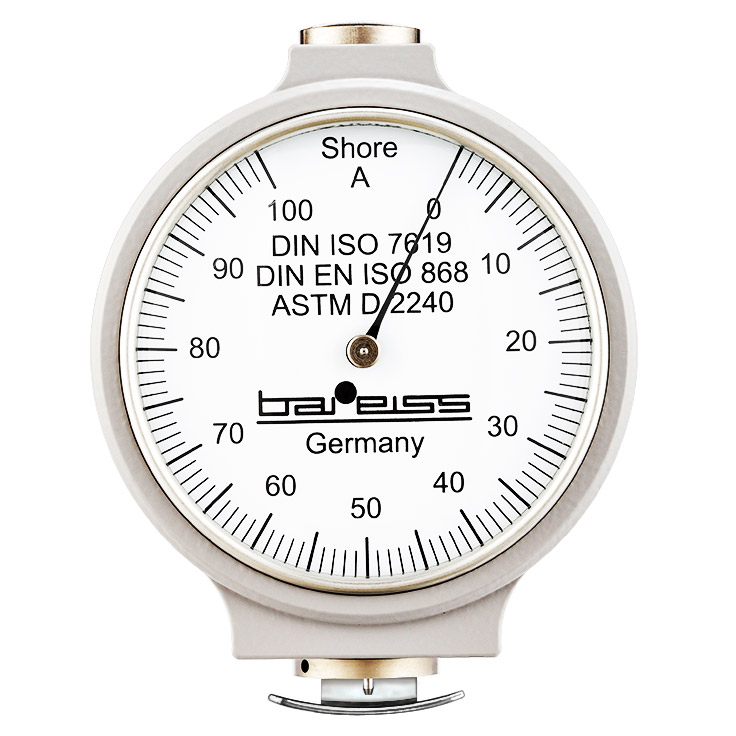
Classic Analogue Shore Durometer with Test Stand Options
This German-manufactured system has been the global benchmark of Shore hardness testing systems since 1954. With ever enhanced ergonomic design, the HP Shore Hardness Tester is both visually appealing and precise rubber and plastic testing system as it has been for nearly 50 years.
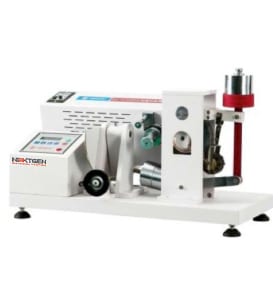
Akron Abrasion Tester
GenKron is used together with a special balance for testing the abrasive consumption of materials. The measurements are done through volumetric loss of a rotating specimen exposed to the action of a standard grinding wheel. It is especially suited for testing harder materials such as shoe soles, tires and other rubber materials.

Burst Strength Tester for Fabric
GenBurst is the Burst Strength Tester designed to test anti-rupture strength of variety of materials such as leather, paper and fabric.

DIN Abrasion Tester
GenDin, is designed to conform to the ASTM D5963 and IS0 4649 standards. This top quality and highly popular abrasion tester will allow you to measure the abrasion resistance of rubbers (vulcanized thermo set rubbers and thermoplastic elastomers) that are subject to abrasive/frictional wear on their actual service. Since wear is always a result of abrasion, different test methods have been developed for the simulation of long term wear.

Demattia Flex Cracking Tester
GenFlex tests the ability of rubber products to withstand repeated flexing without developing cracks is of prime importance where such products are used in conditions undergoing repeated flexing. Flexing endurance of rubber products is determined by simulating in laboratory the action of flexing repeatedly under standard conditions of speed, mode, and degree of flexing.
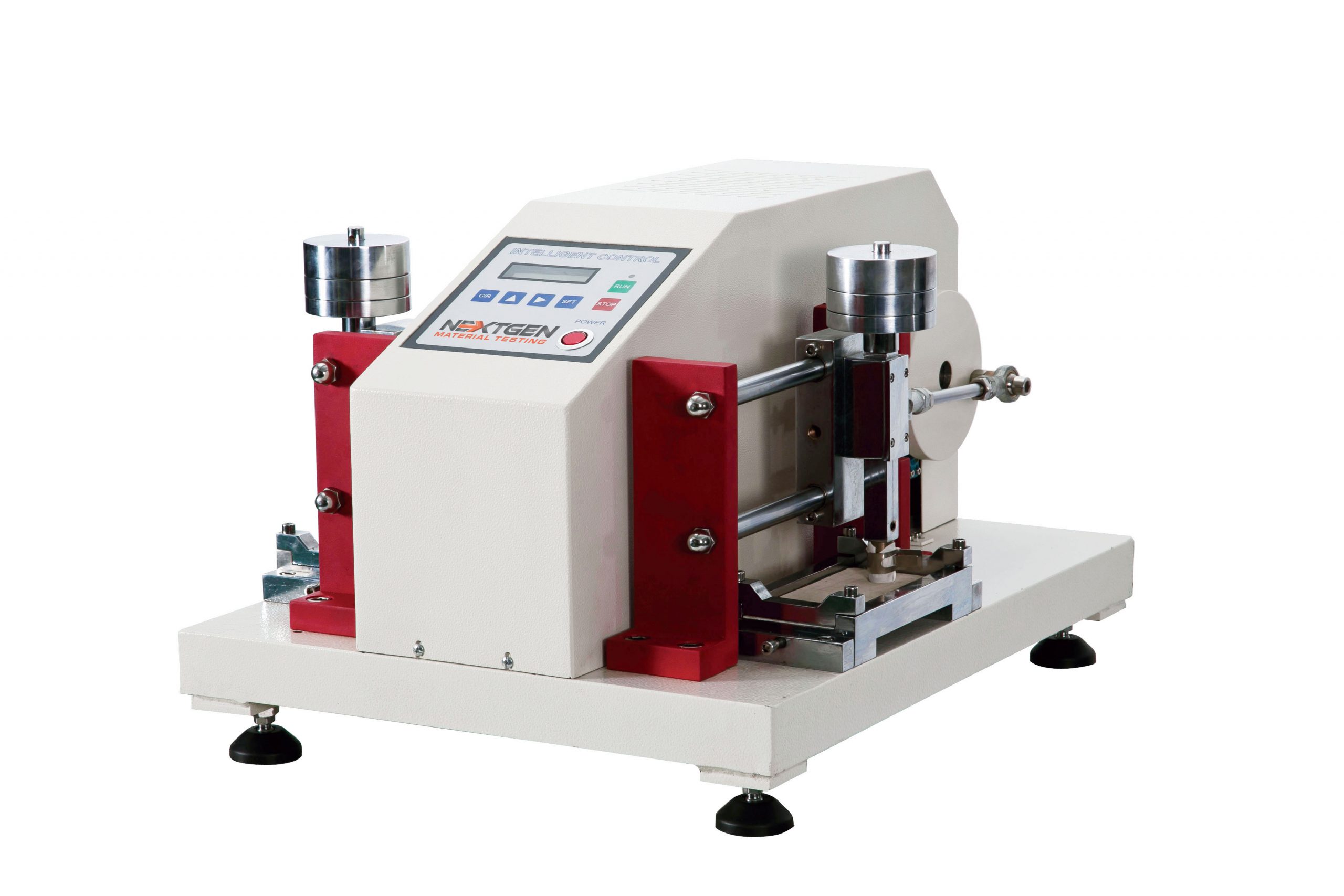
Electric Crocking Tester - GenCrock
The machine is used to test the dyeing of the fabric, and the fade degree of the leather after dry or wet rubbing. The test method involves the specimen to be fastened to the base of the crocking meter and rubbed with an abrasive hammer attached to a wet or a dry cloth under controlled conditions. The transfer of colour is then measured using a scale to evaluate the rating of the specimen's dyeing grade.

Freezing Tester - GenFreeze
GenFreeze is specially designed to test the characteristics of various materials in a cold environment to ensure suitability for use in a cold climate. Based on the testing demand, adjust the beater and flexing grip, then load to the desired position. It can be used to test rubbers, leather, and plastics, PU leather etc. The unit can be adjusted to meet different requirements.

Martindale Abrasion Tester - GenDale
GenDale is mainly used to test shoe fabric, shoe lining, and many other types of shoe related materials. The unit can test up to four specimens at the same time for abrasion. The fabric specimen is measured by having rubbing applied on it via a complex direction of back and forth motion. The accuracy of abrasion strength is determined by the specific number of cycles conducted until a hole appears in the test area of the fabric specimen.

Mooney Viscosity Testing Machine - GenMooney
GenMooney is a viscosity testing machine is applied to measure the viscosity of the unmixed or mixed unvulcanized natural rubber, synthetic rubber and regenerated rubber .This tester has many functions such as fast warming, maintaining temperature, data stability, etc. It is equipped with an automated calibration feature for a simple data calibration of each experiment.

NBS Rubber Abrasion Tester - GenNBS
GenNBS is used to test the abrasion resistance of vulcanized rubber or other rubber compounds. It is commonly used for the soles and heels of footwear. It has an intelligent power failure recovery system. The unit conducts measurements through volumetric loss of specimens exposed to the action of a normalized abrasive medium secured to a rotations cylinder.

Oscillating / Automatic Disc Rheometer (ODR)
This machine is designed to get the characteristic curve and characteristic parameters of rubber vulcanization by measuring the applied moment of rubber to the oscillating dye body. NG-ODR rotor-free vulcameter has an excellent stability of results. The data and diagrams can be used as a reference for development, research and production quality.

Salt Spray Tester - GenSalt
GenSalt is designed to test the surface of different materials for resistance to corrosion. The unit is commonly used to test coated materials of a metallic nature in a controlled corrosive environment. The test can be used on rust-proof painting, anodizing, electroplating and rust-proof of grease. The machine imitates expedited corrosion process via salt spraying on a given test sample to identify the corrosion (oxides) resistance. Test results are based on the longevity of time a material can resist visible corrosion on the test sample.

Wyzenbeek Abrasion Tester - GenWyze
The machine is designed to test the abrasion resistance of fabrics and metals. The abrasion of fabrics is tested when the specimen is pulled over the frame and rubbed against an abradant over a curved surface. The number of cycles, also known as double rubs, conducted on the specimen before the fabric shows visible wear is used to determine the rating of abrasion.

Vertical Rebound Resilience Tester - GenRebound
GenRebound tests the resilience of rubber compounds. The machine must be adjusted in a horizontal position and the plunger raised at a specific height. The plunger is then released onto the specimen for a given number of impacts. The measurements are based on the 4th, 5th, and 6th impacts. The average of the three (3) measurements is then calculated for the test result. The machine is highly useful in production of compounds designed to absorb vibration or shock according to the ASTM standards.

Digital Densimeter Systems
Description The NG-DM-A Series offers high-accuracy digital Densimeters designed for a wide variety of material testing needs. These elegant and compact densimeter systems offer capacity ranges from 150g to 3000g with accuracy of 0.001g/cm3 down to 0.0002g/cm3. Advanced Densimeter System […]

Ross Flex Tester
Ross Flex Tester is designed to determine the resistance of vulcanized or synthetic elastomers to cut growth. The system does so under continuously bend flexing in 90°.

